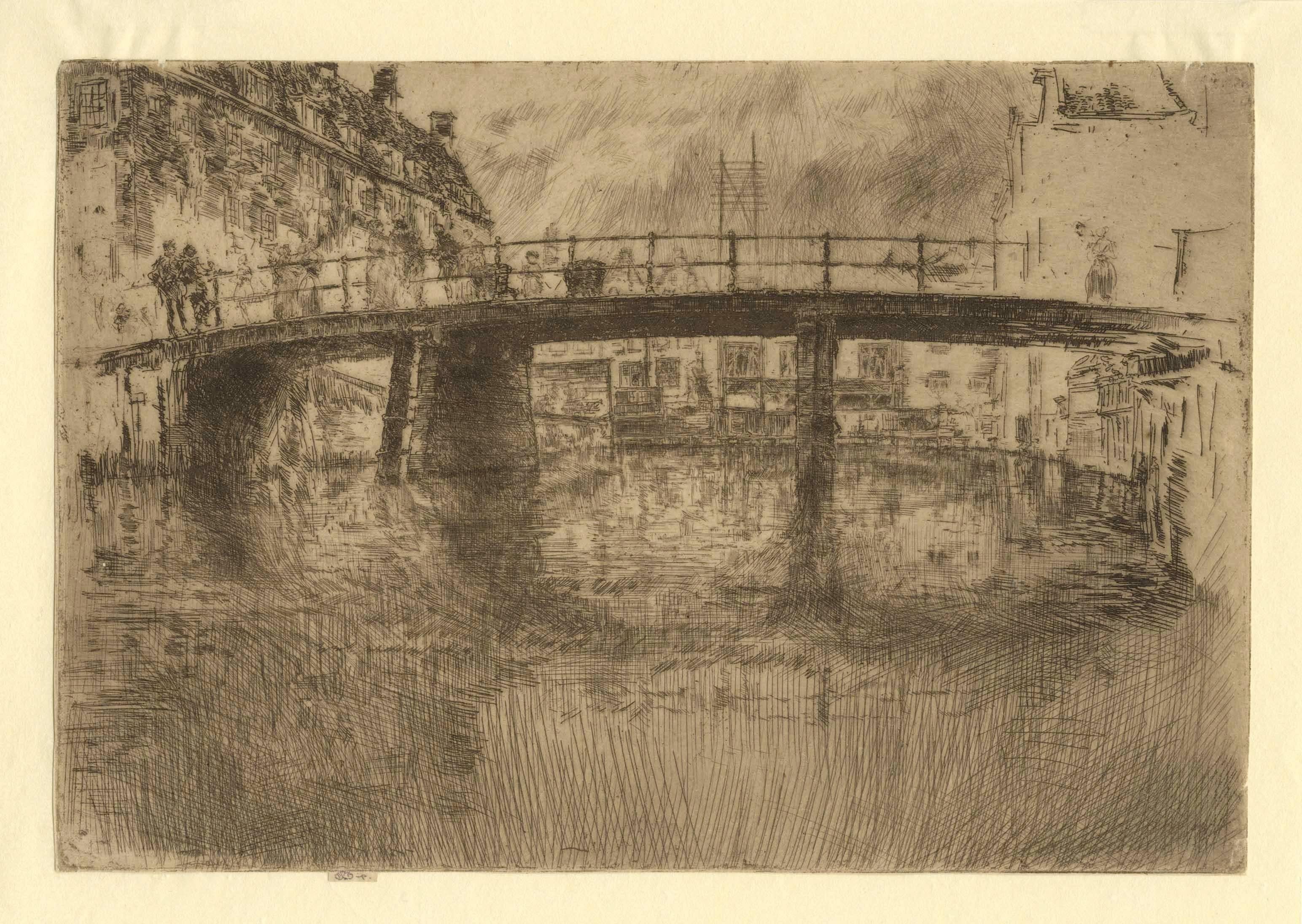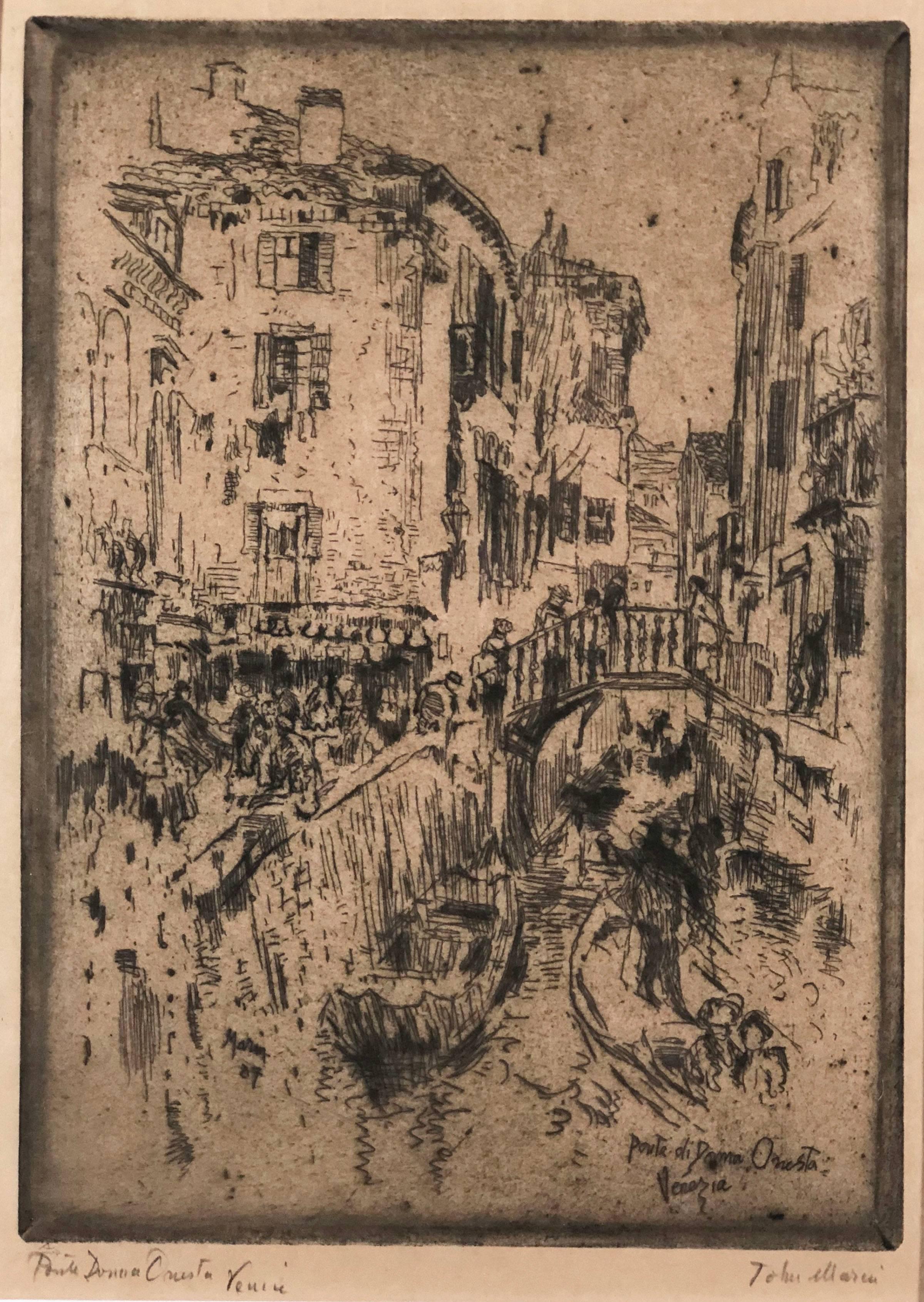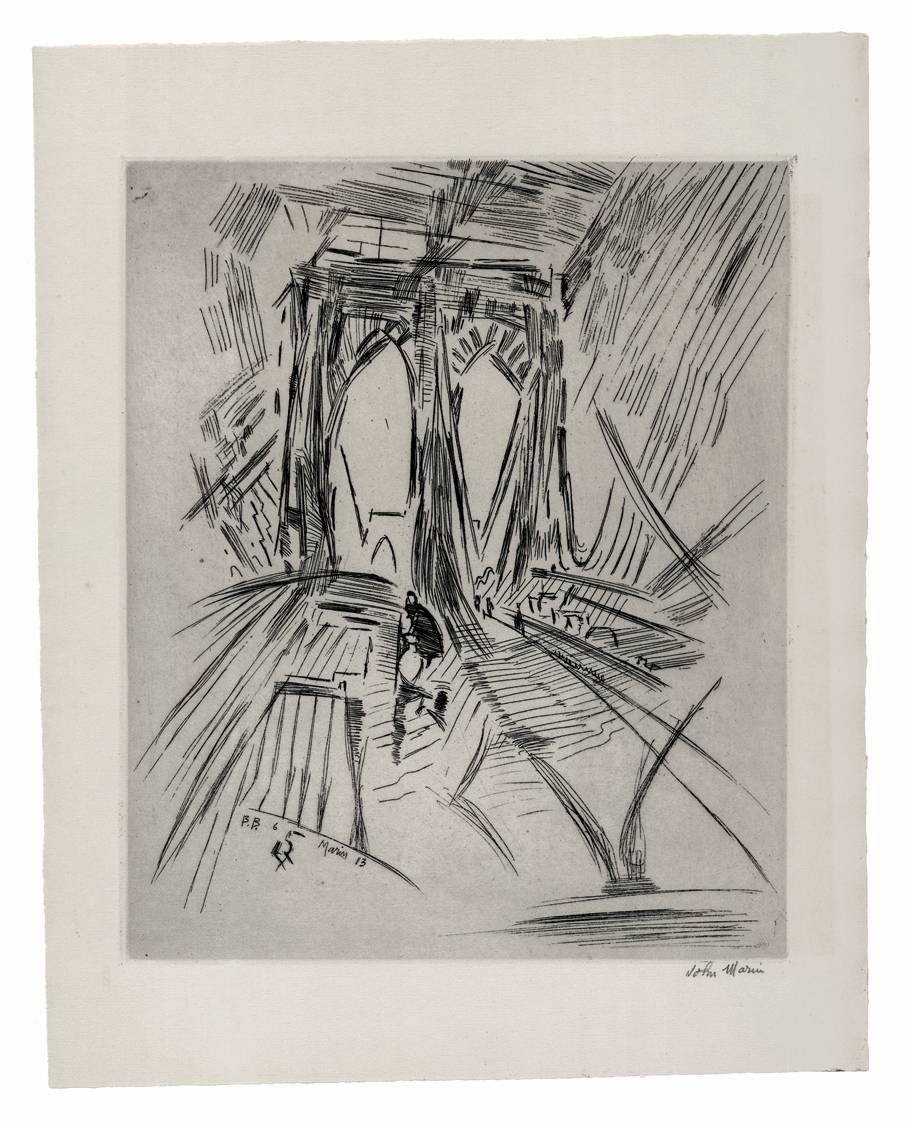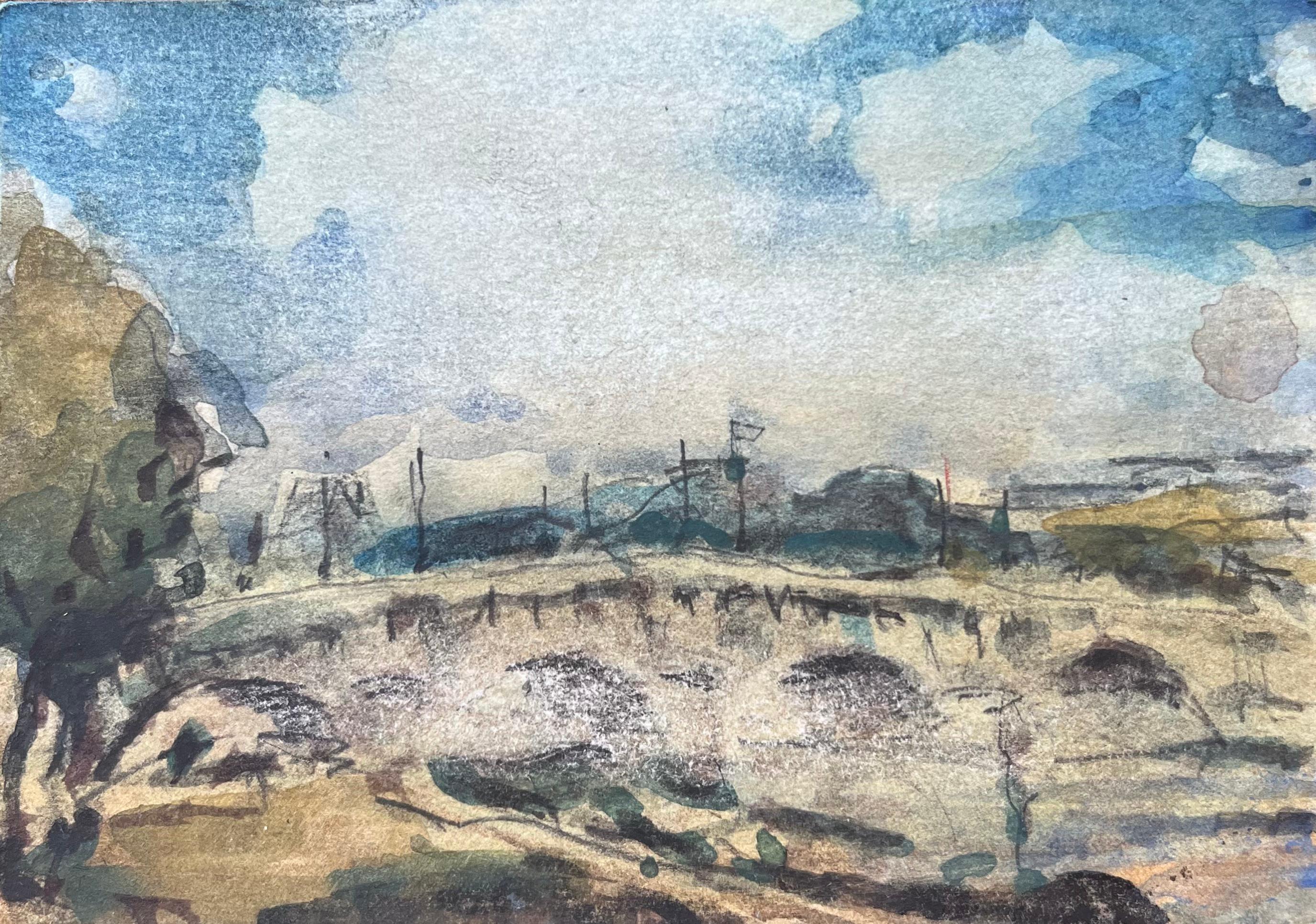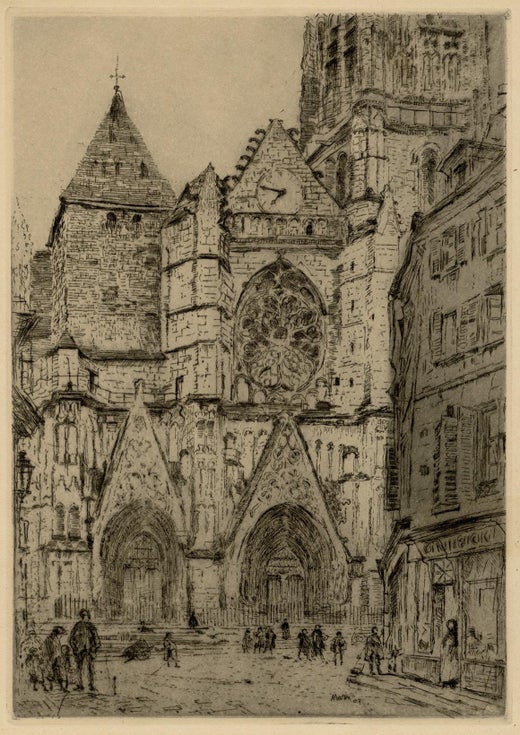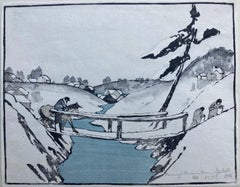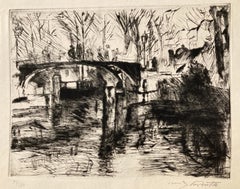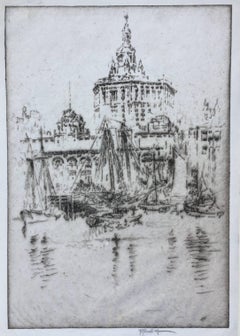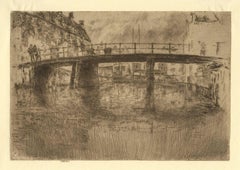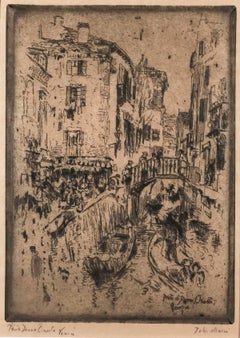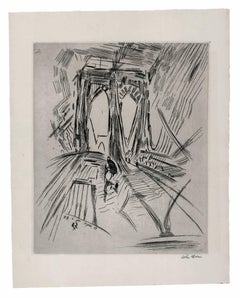Items Similar to CANAL BRIDGE AMSTERDAM
Want more images or videos?
Request additional images or videos from the seller
1 of 8
John MarinCANAL BRIDGE AMSTERDAM1906
1906
$5,100
$6,95026% Off
£3,899.26
£5,313.6926% Off
€4,467.53
€6,088.1126% Off
CA$7,193.59
CA$9,803.0226% Off
A$7,831.98
A$10,672.9926% Off
CHF 4,182.03
CHF 5,699.0426% Off
MX$94,544.27
MX$128,839.7426% Off
NOK 52,575.57
NOK 71,647.1126% Off
SEK 48,901.40
SEK 66,640.1426% Off
DKK 33,370.31
DKK 45,475.2326% Off
About the Item
JOHN MARIN (1872 -1953)
CANAL BRIDGE AMSTERDAM, 1906 (Zigrosser 13 i/ii)
Etching, drypoint and plate tone. A PROOF IMPRESSION of the 1st state, Annotated: “APPROVED MARIN”. Image 6 x 7 ½” Published edition of 30. A fine impression with considerable delicate wiping. This striking composition anticipates Marin’s modernist design in subsequent years. Arguably his most accomplished early European composition. Clearly shows the influence of Whistler. FULL but irregular deckled margins. Small printers crease lower right plate edge into image. $6,950
- Creator:John Marin (1870-1953, American)
- Creation Year:1906
- Dimensions:Height: 6 in (15.24 cm)Width: 7.5 in (19.05 cm)
- Medium:
- Movement & Style:
- Period:
- Condition:
- Gallery Location:Santa Monica, CA
- Reference Number:1stDibs: LU41132409843
John Marin
John Marin was born in Rutherford, New Jersey in 1870. His father was a public accountant; his mother died nine days after his birth. He was taken to his maternal grandparents with whom he lived in Weehawken, New Jersey. His grandparents, with their son and two daughters were the only parents Marin was to know; it has been suggested that his father seems to have ignored him. As a child of seven or eight Marin began to sketch and when he was a teenager he had completed his earliest watercolors. His education in the schools of New Jersey was interspersed with summers of hunting, fishing and sketching; he traveled in the Catskills, and as far away as Wisconsin and Minnesota. But formal training was almost incidental to his development as an artist. He is to America what Paul Cezanne was to France - an innovator who helped to oppose the influence of the narrative painters, the illustrators who were more interested in subject than form, in surface than substance. Marin brought to his work a combination of values which, at the turn of the century, was unique in this country: an aliveness of touch, colors that have both sparkle and solidity, and forms that are vibrant with an energy characteristic of our age. Marin established himself as a practicing architect. In the early 1890s, he worked for four architects and by 1893 had designed six houses in Union Hill, New Jersey. At the age of twenty-eight, he decided to become a professional artist and studied briefly at the Pennsylvania Academy of Fine Arts in Philadelphia and the Art Students League in New York City. As a watercolorist he had no equal. He used this fluid, spontaneous medium to abstract from objects - skyscrapers, boats, mountains and seas - a simplified anatomy of color and form and to define the pulsation of stresses and movements in the relationship of objects. It was a great disappointment, all his life, that his oil paintings did not achieve the popularity that his watercolors did. From 1905 to 1910 he worked in Europe, where he was influenced by Whistler's watercolors. It was Alfred Stieglitz, Marin's lifetime friend and dealer, whose firm faith in his genius made his position in the art world possible. He developed a distinctive style that he used most characteristically in powerful watercolors of the Maine coast. During the 1920s he provided the dominant force in the movement away from naturalistic representation towards an art of expressive semi-abstraction. He married Marie Jane Hughes after he returned to New York. They had one son, who grew up to run his father's considerable affairs. Marin continued to work at the same steady fast pace as long as he lived. Since 1908 he had produced 1700 paintings, an average of forty a year. He had made the frames for them as well. At the age of seventy-nine, he began to taper off from the days when he painted one hundred watercolors in a summer. He died in 1953.
About the Seller
5.0
Recognized Seller
These prestigious sellers are industry leaders and represent the highest echelon for item quality and design.
Gold Seller
Premium sellers maintaining a 4.3+ rating and 24-hour response times
Established in 1977
1stDibs seller since 2016
298 sales on 1stDibs
Typical response time: 1 hour
Associations
International Fine Print Dealers Association
- ShippingRetrieving quote...Shipping from: Santa Monica, CA
- Return Policy
More From This Seller
View AllThames Warehouses
By James Abbott McNeill Whistler
Located in Santa Monica, CA
JAMES McNEILL WHISTLER (American 1834–1903 London)
THAMES WAREHOUSES, 1859 (K 38 ii/ii; Glascow 46 iv/v; Mansfield 37)
Etching and drypoint on fine thin laid paper. Plate: 3 × 8 i...
Category
1850s Impressionist Landscape Prints
Materials
Drypoint, Etching
The Bridge
By Bror Julius Olsson Nordfeldt
Located in Santa Monica, CA
B. J. O. NORDFELDT (Bror Julius Olsson) 1878-1955)
THE BRIDGE, 1906
Color woodcut signed, dated 1906 and numbered 150 in pencil. Image 8 x 10 - small margins as issued. 4 corners tipped to acid free support board. Nordfelt is one of the most important early twentieth century American Masters of the Color woodcut. This 1906 work predates many of the other woodcut masters. Nordfeldt had a peculiar numbering system. The number is not necessarily the edition number.
Frances H. Gearhart, Blanche Lazzell, William S. Rice, Gustave Baumann, Margaret Patterson, Norma Basset Hall. Waldo Chase.
Category
Early 1900s American Modern Landscape Prints
Materials
Woodcut
AUS DEM TIERGARTEN
By Lovis Corinth
Located in Santa Monica, CA
LOVIS CORINTH (1858-1925)
AUS DEM TIERGARTEN 1920 (Schwartz 397)
Drypoint, signed and numbered 47/50. BEAUTIFUL IMPRESSION with RICH DRYPOINT. Plate 9 ½ x 12 ½ inches. Full margins...
Category
1920s Impressionist Prints and Multiples
Materials
Drypoint
New Fish Market - NEW YORK
By Joseph Pennell
Located in Santa Monica, CA
JOSEPH PENNELL (1857 - 1926)
NEW FISH MARKET - (NEW YORK) 1921 (W 797)
Etching, Signed in pencil, edition probably 50. 9 7/8 x 6 7/8 inches. Full sheet, ...
Category
1920s American Impressionist Landscape Prints
Materials
Etching
$375 Sale Price
40% Off
LUDGATE HILL
By Joseph Pennell
Located in Santa Monica, CA
JOSEPH PENNELL (1857- 1926)
LUDGATE HILL, 1906 (Wuerth 418)
Etching 10 ½ x 8 ¼ inches on full sheet 11 3/8 x 9 7/8 inches. with irregular deckle edges. Good condition. Wuerth’s assu...
Category
Early 1900s Impressionist Landscape Prints
Materials
Etching
SUNSET IN IRELAND (undescribed state?)
By Sir Francis Seymour Haden, R.A.
Located in Santa Monica, CA
SIR FRANCIS SEYMOUR HADEN (British 1818 -1910)
SUNSET IN IRELAND 1863 (Schneiderman 47 - Appears to be an undescribed state between XI and XII)
Etching and drypoint, signed in penci...
Category
1860s Impressionist Landscape Prints
Materials
Drypoint
You May Also Like
Bridge, Amsterdam
By James Abbott McNeill Whistler
Located in New York, NY
James McNeill Whistler (1834-1903), Bridge, Amsterdam, etching, 1889, printed in brown ink on thin laid paper, signed with the butterfly on the tab and annotated “imp”, also signed with the butterfly on the verso and numbered 11. References: Kennedy 409, Glasgow 447, fifth state (of 5). In very good condition (slight nicks at edges), trimmed by the artist on the plate mark apart from the tab, 6 1/2 x 9 1/2 inches.
Provenance:
Vivian and Meyer P. Potamkin, Philadelphia;
sale, Sotheby’s, New York, May 11, 1989, lot 302
Samuel Josefowitz, Pully, Switzerland
A very fine, shimmering impression of this great rarity.
This impression is included in the Glasgow inventory, ID number K4090301; only about 11 lifetime impressions in all states are known (three were also printed posthumously by Nathaniel Sparks...
Category
1880s Impressionist Landscape Prints
Materials
Etching
Ponte di Donna Onesta, Venice
By John Marin
Located in Missouri, MO
Very rare etching by John Marin.
"Ponte di Donna Onesta, Venice" 1907
Original Etching
Hand Signed Lower Right
Titled Lower Left
Edition: c. 30
Cat. Rais: ...
Category
Early 1900s Abstract Landscape Prints
Materials
Etching
Price Upon Request
Paris, Le Pont Neuf
By Arnold A. Grossman
Located in San Francisco, CA
This artwork titled "Paris, Le Pont Neuf" c.1990 is an original color aquatint by noted California artist Arnold A. Grossman, 1923-2016. It is signed with...
Category
Late 20th Century American Impressionist Figurative Prints
Materials
Aquatint
Brooklyn Bridge No. 6 (Swaying)
By John Marin
Located in New York, NY
John Marin (1870-1953), Brooklyn Bridge No. 6 (Swaying), 1913, Etching.
Z112. Edition c. 12 (Steiglitz); 1924, unknown but small (New Republic). Signed in pencil. Signed and dated...
Category
1910s Cubist Landscape Prints
Materials
Etching
Paris, Le Pont Neuf
By Arnold A. Grossman
Located in San Francisco, CA
This artwork titled "Paris, Le Pont Neuf" c.1990 is an original etching by noted California artist Arnold A. Grossman, 1923-2016. It is signed with initia...
Category
Late 20th Century American Impressionist Figurative Prints
Materials
Etching
French Impressionist Watercolor of Pont Neuf Parisian Bridge Scene
Located in Cirencester, Gloucestershire
Title: French Impressionist Watercolor of Pont Neuf Parisian Bridge Scene
By Maurice Mazeilie (French 1924-2021)
Medium: Watercolor on paper, unframed
Size: 4 x 5.75 inches (Height ...
Category
20th Century Impressionist Drawings and Watercolor Paintings
Materials
Watercolor
$171 Sale Price
30% Off
More Ways To Browse
Antique Bridges
Roy Lichtenstein Sunrise
Salvador Dali The Alps
Salvador Dali Venice
Stephen McMillan On Sale
Stetson Etching
Thomas Kelly Print
Vintage Arsenal Posters
Vintage Standing Santa
Vintage Victory Garden Poster
W Rochelle
Welliver Screen Print
Wilbur Streech
William Irvine
William Simpson On Sale
Wysocki Charles Signed
Indonesian Shadow Puppet
J Muller
